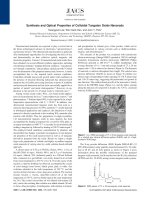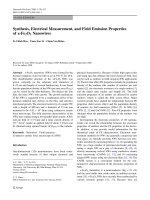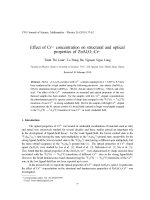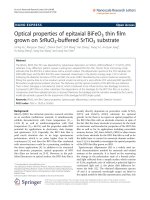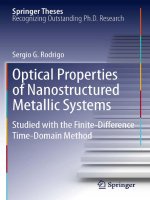Far field and near field optical properties of planar plasmonic oligomers
Bạn đang xem bản rút gọn của tài liệu. Xem và tải ngay bản đầy đủ của tài liệu tại đây (4.84 MB, 140 trang )
FAR-FIELD AND NEAR-FIELD OPTICAL PROPERTIES OF PLANAR
PLASMONIC OLIGOMERS
MOHSEN RAHMANI
NATIONAL UNIVERSITY OF SINGAPORE
2012
FAR-FIELD AND NEAR-FIELD OPTICAL PROPERTIES OF PLANAR
PLASMONIC OLIGOMERS
MOHSEN RAHMANI
A THESIS SUBMITTED FOR THE DEGREE OF
DOCTOR OF PHILOSOPHY
DEPARTMENT OF ELECTRICAL AND COMPUTER ENGINEERING
NATIONAL UNIVERSITY OF SINGAPORE
2012
This PhD thesis is dedicated to our newborn “Sofia” who has brought happiness to our life.
DECLARATION
I hereby declare that this thesis is my original work and it has been written by me in its
entirety. I have duly acknowledged all the sources of information which have been used in
the thesis. This thesis has also not been submitted for any degree in any university
previously.
(Mohsen Rahmani)
i
Acknowledgements
I would like to express my heartiest appreciation and gratitude to my supervisors, Prof.
Thomas Yun Fook Liew and Prof. Minghui Hong for their invaluable guidance and great
support throughout my PhD course. I would like to thank them for giving me the numerous
opportunities to learn and grow as a PhD student. Particularly, I am truly grateful to Prof.
Hong for his kind assistance towards the difficulties that I have faced in my personal life as
well as his infinite passion in research work, which inspires me to work hard. Meanwhile,
much appreciation goes to Prof. Boris Lukiyanchuk for his helps, advices and useful
discussions in my researches.
It is my pleasure to appreciate all my lab members, Caihong, Zhiqiang, Tang Min, Hong
Hai, Chin Seong, Doris, Xu Le, Nguyen Thi Van Thanh, Liu Yan, Li Xiong, Han Ningren, Ng
Binghao and specially my dear friend Zaichun as well as my friends in DSI and IMRE, Amir (T),
Mojtaba, Taiebeh, Behruz, Mehdi, Mojtaba (R), Sepehr, Sepideh, Hamed (A), Mahnaz, Amir
(M), Hamed (K) and specially Meisam. I deeply appreciate the time shared with you and I
wish you the best luck in your careers. I also thank Prof. Stefan A. Maier, Prof. Harald
Giessen, Prof. Peter Nordlander, Prof. Andrey Miroshnichenko, Dr. Dang Yuan Lei and Dr.
Vincenozo Giannini for useful discussions and comments. I would like to express gratitude
for the financial support from the A*STAR Singapore International Graduate Award (SINGA)
program and DSI for their numerous support.
Last but the most importantly, I would like to give my great thanks to my parents and
my lovely wife Yana. Thank you for your love all the while which gives me the strength to
carry on.
ii
Table of Contents
i
ii
iv
vi
xi
xii
xiii
Acknowledgments
Table of Contents
Abstract
List of Figures
List of Tables
List of Symbols
List of Publications
1
CHAPTER 1. Introduction
4
6
14
18
21
1.1. Background and literature review
1.1.1. Fano resonance definition
1.1.2. Fano resonance in plasmonic systems
1.1.3. Fano resonance in plasmonic oligomers
1.2. Research motivation
23 1.3. Organization of thesis
2
6
CHAPTER 2. Experiment
27 2.1. Fabrication
28
28
2.1.1. Substrate cleaning
2.1.2. Metallic film deposition
29 2.1.3. Resist coating
30
2.1
.4
.
Exposure and develop
33 2.1.5. Pattern transfer
3
5
2.2
. Characterization
35
37
38
3
9
2.2.1. Scanning electron microscopy
2.2.2. Atomic force microscopy
2.2.3. Micro UV-Visible spectroscopy
2.2
.4
.
Fourier transform infra
-
red spectroscopy
40
40
2.3. Simulation
2.4. Summary
42
CHAPTER 3. F
ar
-
field optical properties of o
ligomers:
Generation of
pronounced Fano resonance
44
49
51
53
56
58
59
60
62
3.1. Destructive interference among dipole modes
3.2. Mass-spring mechanical model
3.3. Influence of components` geometry on Fano Resonance
3.4. Subgroups decomposition
3.5. Geometrical hybridization
3.6. Monolith oligomeric structures
3.6.1 90
o
Rotor-shaped structure
3.6.2 Hybrid pentamers with central rotor-shaped element
3.7. Symmetry breaking
iii
68 3.8. Summary
70
CHAPTER 4
.
Far
-
field optical properties of quadrumers
71
78
80
88
4.1. Analogy to molecular configurations
4.2. Mass-spring analogy
4.3. Geometrical influence
4.4. Summary
90
CH
APTER 5
. Ne
ar
-
field optical properties of o
ligomers: Energy
localization
92
94
98
99
10
2
5.1. Near-field localization
5.2. Influence of geometry on the near-field energy
5.3. Influence of defects on the near-field energy
5.4. Near-field energy enhancement by rotor-shaped structures
5
.
5
.
Summary
103
CHAPTER 6
.
C
onclusions and future work
104
10
5
6.1. Conclusions
6
.2
.
Future works
107
References and links
iv
Abstract
Recently, a large number of experimental and theoretical works has revealed a variety of
plasmonics nanostructures with the capabilities of Fano Resonance (FR) generation. FR
exhibition in most nanostructures needs an excited high-order mode with a very narrow
linewidth and its interference with a dipole mode which has a broad spectrum response. The
excitation of such high-order modes is typically established by challenging complex
structures or geometrical symmetry breaking at certain polarization direction of incident
light. Newly introduced planar plasmonic oligomers, consisting of packed metallic
nanoelements, tackle these challenges. Such structures can exhibit FR independently of
polarization direction based on the anti-parallel dipole modes rather than an overlap
between dipole and high-order modes. Nonamers and heptamers are well studied oligomers
exhibiting FR as the result of anti-parallel hybridization among the dipole mode arising from
the central nanoparticle and net dipole mode arising from the ring-like satellite elements
with opposite phase characteristics.
In this thesis a way to increase the value of ratio among anti-parallel dipole modes is
investigated by reduction of the number of surrounding satellite elements to enhance the
contrast of FR. Pentamers and quadrumers are novel oligomers which can realize this goal.
Meanwhile, it is shown that hybridization of plasmons arising from individual elements of
such oligomers can be modeled in good agreement with mechanical mass-spring analogues.
It provides better understanding of interaction among plasmons arising from individual
elements. Furthermore, detailed study on the spectral shape of resonances guided us to
propose a recipe to flexibly control the Fano profile signature. The effects of elements` size,
gap among them and symmetry breaking on FR in such structures are also studied in details.
v
Subsequently, it is shown that while the far-field optical properties of oligomers are
polarization independent, the near-field energy can be flexibly re-distributed inside the
arbitrary inter-particle gaps by changing the polarization orientation. This tuneability is
obtained at a normal incidence of a single light source rather than by co-illumination with
two light sources at different incident angles or with respective phase shifts. Meanwhile, it is
shown that as compared to the regular oligomers consisting of circular elements, hybrid
oligomers with rotor-shaped central elements are better candidates to enhance the
exhibited near-field energy among the gaps significantly. Such structures allow achieving
more precise localization of the near-field energy.
One should note here that all results provided in this thesis are fundamental research
works to generate and optimize FR in plasmonic oligomers as well as localizations,
enhancement and tuning of near-field energy in such structures. These findings suggest high
potential applications in optical switching, slow-lighting, nonlinear spectroscopy and bio-
chemical sensing.
vi
List of Figures
Figure 1. 1 Illustration of two coupled interacting oscillators.
Figure 1. 2 (a) The resonant behavior of the amplitude of the first oscillator in the
coupled system. (b) The phase behavior of the first oscillator amplitude around the
resonances.
Figure 1. 3 (a) The amplitude of the second oscillator as a function of the frequency. (b)
The phase behavior of the second oscillator.
Figure 1. 4 Extinction spectra of a gold monomer, a gold hexamer, and gold hepatmers
with different inter-particle gap separations.
Figure 2. 1 Illustration of fabrication steps.
Figure 2. 2 Schematic drawing of an electron beam evaporator.
Figure 2. 3 Schematic drawing of an EBL system.
Figure 2. 4 Schematic drawing of an ion beam process system.
Figure 2. 5 Schematic drawing of a scanning electron microscopy system.
Figure 2. 6 (a) Simplified schematic of a AFM system and (b) Diagram of relationship
between force and tip distance from the surface for different AFM modes.
Figure 3. 1 (a) Sketch of pentamer arrays. SEM images of periodic array patterns of (b)
monomers, (c) ring-like quadrumers and (d) pentamers. Scale bar is 100 nm.
Figure 3. 2 (a) Simulated and (b) experimental transmission spectra of monomers,
quadrumers and pentamers at x-polarized normal incidence.
Figure 3. 3 Calculated charge distributions for the ring-like quadrumer (a) before the
resonance at 600 nm and (b) after the resonance 700 nm and (c) Charge distribution of the
pentamers structure at a wavelength of 665 nm.
vii
Figure 3. 4 (a) Five coupled interacting oscillators representing the pentamer optical
responses, (b) simplified three coupled oscillators and (c) simulated plasmons absorption
spectra by FDTD (dot line) and calculated power absorption in the oscillator model (solid
line).
Figure 3. 5 Simulated transmission spectra of 6 various types of pentamers at x-polarized
normal incidence.
Figure 3. 6 (a) SEM image of a periodic array of pentamers consisting of Au disks. The
scale bar is 100 nm. (b) Simulated extinction spectra of an individual pentamer (black curve)
and the two subgroups (blue and red curves). (c) Sketch of decomposing a pentamer into
Groups I and II. (d) Electric field intensity distribution in the pentamer at peaks 1 and 2 and
in the two subgroups at their respective scattering peaks 3 and 4. (e) Measured extinction
spectrum of the pentamer array at normal incidence. The inset shows a 3D AFM image of
the pentamers and the incident polarization.
Figure 3. 7 Tuning of resonance linewidth and spectral contrast of plasmon resonances in
different pentamers. (a) SEM images of hybrid pentamers consisting of differently-shaped
elements. The scale bar in each image is 100 nm. (b) Simulated extinction spectra for the
pentamers (black curve) and their two subgroups (blue and red curves). (c) Measured
extinction spectra for the same pentamers at normal incidence, along with 3D AFM images
of the nanostructures.
Figure 3. 8 (a) SEM images of 90° symmetric rotor-shaped nanostructures, (b) simulated
and (c) experimental extinction spectra of the corresponding structures in (a) at indicated
polarization excitation with respect to x-axis. Scale bar is 100 nm.
viii
Figure 3. 9 (a) SEM images of designed hybrid pentamers and quadrumers, (b) simulated
and (c) experimental extinction spectra of the corresponding structures in (a) at indicated
polarization excitation with respect to x-axis. Scale bar is 100 nm.
Figure 3. 10 SEM images of periodic array nanopatterns of (a) the Type I symmetric
pentamer, the (b) Type II and (c) Type III asymmetric pentamers. The offset of the central
disk for the Type II and Type III asymmetric pentamers are 6 nm and 12 nm, respectively
leading to a corresponding gap of 9 nm and 3 nm gaps. (d), (e) and (f) simulated and
experimental reflection spectra of the corresponding pentamers in (a), (b) and (c). Diameter
of each disk is 125 nm.
Figure 3. 11 Calculated charge distribution of the Type III pentamer at a wavelength of (a)
650 nm and (b) 580 nm. (c) Calculated forward and backward far-field scattering for the
Type I, II and III pentamers, respectively.
Figure 3. 12 Simulated FDTD (red line) and oscillator model calculated (black line)
extinction spectra for pentamer Type III.
Figure 4. 1 (a) (Upper row) Illustrations of the molecular geometries of an H atom and
the trigonal planar molecule configuration. (bottom row) Their plasmonic analogues, a gold
monomer and a gold quadrumer. SEM images of periodic array patterns of (b) monomers
and (c) quadrumer. Scale bar is 100 nm. (d) AFM image of quadrumers.
Figure 4. 2 (a) Simulated and (b) measured reflection spectra of the monomers and
quadrumers at x-polarized normal incidence. Calculated charge distribution of the
quadrumer at a wavelength of (c) 640 nm and (d) 780 nm by FDTD simulation.
Figure 4. 3 (a) Three coupled interacting oscillators representing the quadrumer optical
responses and corresponding calculated power absorption, and (b) simulated extinction
spectra of the quadrumer at x-polarized normal incidence by FDTD.
ix
Figure 4. 4 Simulated transmission spectra of 6 various types of pentamers at x-polarized
normal incidence.
Figure 4. 5 (a) SEM image of a periodic array of quadrumers consisting of Au disks. The
scale bar is 100 nm. (b) Simulated extinction spectra of an individual quadrumer (black
curve) and the two subgroups (blue and red curves). (c) Sketch of decomposing a quadrumer
into Groups I and II. (d) Electric field intensity distribution in the pentamer at peaks 1 and 2
and in the two subgroups at their respective scattering peaks 3 and 4. (e) Measured
extinction spectrum of the pentamer array at normal incidence. The inset shows a 3D AFM
image of the pentamers and the incident polarization.
Figure 4. 6 Tuning of resonance linewidth and spectral contrast of plasmon resonances in
different quadrumers. (a) SEM images of hybrid quadrumers consisting of differently-shaped
elements. The scale bar in each image is 100 nm. (b) Simulated extinction spectra for the
pentamers (black curve) and their two subgroups (blue and red curves). (c) Measured
extinction spectra for the same pentamers at normal incidence, along with 3D AFM images
of the nanostructures.
Figure 4. 7 (a) SEM images of 120° symmetric rotor-shaped nanostructures, (b)
simulated and (c) experimental extinction spectra of the corresponding structures in (a) at
indicated polarization excitation with respect to x-axis. Scale bar is 100 nm.
Figure 4. 8 (a) SEM images of designed hybrid quadrumers, (b) simulated and (c)
experimental extinction spectra of the corresponding structures in (a) at indicated
polarization excitation with respect to x-axis. Scale bar is 100 nm.
Figure 5. 1 Calculated field distributions at x-polarized normal incidence at a wavelength
of 880 nm and at (a) x-polarized (b) y-polarized and (c) 45-degree polarized light incidence.
x
Figure 5. 2 Calculated field distribution at x-polarized normal incidence at a wavelength
of 780 nm at (a) 30-degree polarized, (b) 60-degree polarized and (c) non-polarized, to
normal light incidence.
Figure 5. 3 (a) Linear and (b) logarithm scales of the calculated electric field distribution
within the 6 various pentamers at x-polarized normal incidence and a wavelength of the
second deep in the corresponding transmission spectra of Fig. 3.5.
Figure 5. 4 (a) Linear and (b) logarithm scales of the calculated electric field distribution
within the 4 various quadrumers at x-polarized normal incidence and a wavelength of the
second deep in the corresponding transmission spectra of Fig. 4.4.
Figure 5. 5 Calculated near-field energy distribution within the Type III pentamer at x-
polarized normal incidence and a wavelength of 700 nm: (a) x-polarization, (b) y-polarization
and (c) 45-degree polarization, with respect to x axis.
Figure 5. 6 Calculated field distribution at indicated polarization excitation for (a) rotor
shaped structure, (b) regular pentamer and (c) hybrid pentamer at a wavelength of 1010 nm
and structure II at a wavelength of 1025 nm.
Figure 5. 7 Calculated field distribution at indicated polarization excitation for (a) rotor
shaped structure, (b) regular pentamer and (c) hybrid pentamer at a wavelength of 1010 nm
and structure II at a wavelength of 1025 nm.
xi
List of Tables
Table 3. 1 Dimensions of 6 various types of pentamers.
Table 4. 1 Dimensions of 4 various types of quadrumers.
xii
List of Symbols
t
Time (
s
)
x(t)
Oscillator displacement from the equilibrium positions (
m
)
(t)x
&
First derivative of x with respect to time (
s
m
)
(t) x
&&
Second derivative of x with respect to time (
2
s
m
)
γ
Frictional parameter (energy dissipation) of oscillators (W)
ω
Frequency of the external harmonic force (eV)
Ω
Coherent coupling frequency between interconnected oscillators (eV)
ϕ
Phase (Radian)
θ
Phase shift (Radian)
xiii
List of Publications
Journal papers
1. M. Rahmani, B. Lukiyanchuk, B. Ng, A. K. G. Tavakkoli, T. Y. F. Liew, and M. H. Hong,
“Generation of pronounced Fano Resonances and tuning of subwavelength spatial light
distribution in plasmonic pentamers,” Optics Express 19, 4949-4956 (2011).
2. M. Rahmani, B. Lukiyanchuk, T.T.V. Nguyen, T. Tahmasebi, Y. Lin, T. Y. F. Liew and M.H.
Hong, “
Influence of symmetry breaking in pentamers on Fano resonance and near-field
energy localization,” Optical Materials Express 1, 1409-1415 (2011).
3. M. Rahmani, T. Tahmasebi, Y. Lin, B. Lukiyanchuk, T. Y. F. Liew, and M. H. Hong,
“Influence of plasmon destructive interferences on optical properties of gold planar
quadrumers,” Nanotechnology 22, 245204 (2011).
4. M. Rahmani, T. Tahmasebi, B. Lukiyanchuk, T. Y. F. Liew, and M.H. Hong, “Polarization-
controlled spatial localization of near-field energy in planar symmetric coupled
oligomers,” Applied Physics A 107, 23-30 (2011).
5. M. Rahmani, D. Y. Lei, V. Giannini, B. Lukiyanchuk, M. Ranjbar, T. Y. F. Liew, M. H. Hong,
and S. A. Maier, “Subgroup Decomposition of Plasmonic Resonances in Hybrid
Oligomers: Modeling the Resonance Lineshape,” Nano Letters 12, 2101-2106 (2012).
6. M. Rahmani, B. Lukiyanchuk, and M.H. Hong, “Fano resonance in novel plasmonic
nanostructures,” Laser & Photonics Reviews,
DOI: 10.1002/lpor.201200021
(2012).
7. Z. Chen, M. Rahmani, G. Yandong, C. T. Chong and M. H. Hong, “Realization of Variable
Three Dimensional Terahertz Metamaterial Tubes for Passive Resonance Tunability,”
Advanced Materials 24, OP143-OP147 (2012).
8. H. Aouani, M. Navarro-Cia, M. Rahmani, T. P. H. Sidiropoulos, M. Hong, R. F. Oulton, and
Stefan A. Maier, “Multiresonant broadband optical antennas as efficient tunable
nanosources of second harmonic light,” Nano Letters 12, 4997–5002 (2012).
9. J. Yang, M. Rahmani, J. H. Teng, and M.H. Hong, “Magnetic-electric interference in
metal-dielectric-metal oligomers: generation of magneto-electric Fano Resonance,”
Optical Materials Express 2, 1407-1415 (2012).
10. H. Aouani, H. Sipova, M. Rahmani, M. Navarro-Cia, K. Hegnerova, J. Homola, M. Hong,
and Stefan A. Maier, "Ultra-Sensitive Broadband Probing of Molecular Vibrational
Modes with Multifrequency Optical Antennas“, ACS Nano, Published online,
DOI: 10.1021/nn304860t (2012).
xiv
Conference papers
1.
M. Rahmani, T. Tahmasebi, B. Lukiyanchuk, T. Y. F. Liew, and M.H. Hong, “Polarization-
controlled spatial localization of near-field energy in planar symmetric coupled
oligomers”, Poster Presentation, ICMAT 2011-Singapore, Singapore, 26 June-1 July.
2.
M. Rahmani, B. Lukiyanchuk, T. Y. F. Liew, and M.H. Hong, “Design and tuning of Fano-
shape resonances in planar symmetric coupled oligomers”, Invited Talk, PIERS 2012-
Kuala Lumpur, Malaysia, 26-30 March.
3.
M. Rahmani, B. Lukiyanchuk, T. Y. F. Liew, and M.H. Hong, “Planar isotropic rotor-
shaped nanostructures: an alternative to develop oligomers”, Oral Talk, CLEO 2012- San
Jose, USA, 6-11 May.
4.
M. Rahmani, B. Lukiyanchuk, and M. H. Hong, “Hybrid oligomers: design and tuning the
Fano resonance by decoding the contributing bright modes”, Invited talk (/session
chair,) IEEE-INEC 2013-Singapore, 2-4 January.
1
Chapter 1.
Introduction
2
Since Gilileo Galilei recognized the resonance effect in his study of musical strings in 1602,
many types of resonances, such as mechanical, acoustic and electromagnetic, have been
explored as the universal characteristics of various classical and quantum systems. The
spectral dependence of these resonances is generally described by the Lorentzian formula
with dynamical variables arising from a simple linear differential equation [1, 2]. For many
years, the Lorentzian formula was regarded as the fundamental lineshape of a resonance.
This spectral feature is frequently modified by the presence of several independent
resonances of different physical origins, where the lineshape is simply the sum of the
intensities of the individual resonances which contribute to it.
In 1961, Ugo Fano theoretically described distinctly asymmetric shape in the
absorption resonance of noble gases, which was experimentally observed in 1935 by him [3].
This new type of resonance, which was explained via quantum mechanical system, now
bears the name of Fano. The microscopic origin of the Fano Resonance (FR) arises from the
constructive and destructive interferences of a narrow discrete resonance with a broad
spectral line or continuum [1, 3-7]. Until the end of 20
th
century, this phenomenon has been
studied basically for quantum systems. However the basic effect of interference in classical
system of coupling oscillators is well known for a long time and even has been used in
mechanical systems for dynamic damping [8]. Recently Fano interferences have been
applied successfully to explain a large number of phenomena in various systems. These
phenomena include the quantum transport in quantum dots, wires and tunnel junctions [9-
11], energy-dependent line profile of absorption in molecular systems [12, 13], photon-
exciton interactions in bilayer graphene nanostructures [14, 15] and asymmetric distribution
of the density of states in Anderson impurity systems [16] as well as several optical systems,
3
such as strong coupling between Mie and Bragg scattering in photonic crystals [17, 18],
plasmonic systems [19-31] and terahertz metamaterials [32-44].
Among all these systems, the field of plasmonics has become one of the most active
platforms in FR generation and applications due to its ease for generating the coherent
effects [19-31], in last few years. It is well known that metallic nanostructures can sustain
surface plasmons which are the coherent oscillations of the conduction electrons at the
interface between metal and dielectric materials [21]. Since the relevant interaction
parameters can be tuned by changing the geometry and composition of nanostructures,
plasmonic systems have proven to be an ideal choice to generate FRs with sharp dispersion.
In such systems, FR occurs via the spectral overlap of broad superradiant and sharp
subradiant resonance modes, which are typically characteristics of dipolar and high-order
modes, respectively. Comprehensive descriptions of fundamental Fano theory and its
progress through various designs of plasmonic nanostructures can be found in recent
reviews [1-7].
Plasmonic planar oligomers as newly introduced plasmonic nanostructures consisting
of packed aggregated nanoscale metallic components, have also been investigated to exhibit
FR in the visible and near infra-red spectral ranges. These structures are of significant
interest due to their fundamental importance as a model system to understand the nature
of electromagnetic coupling [45-63]. Hybridization of plasmons arising from finite number of
individual elements of oligomers is found to excite multiple plasmon resonances with large
induced electromagnetic field enhancement. Unlike most of the other plasmonic
nanostructures in which a high-order mode and its overlap with a dipole mode is a
requirement to FR appearance [1-7], the sharp FR in the oligomers is generated only by
4
dipole modes with different plasmon oscillation phases arising from various elements [45-
61, 64-66]. It can address the challenges of high order modes excitation and make the
oligomers unique devices for bio-sensing and other potential applications [2]. On the other
hand, while far-field optical properties of oligomers are polarization independent, the near-
field energy can be flexibly redistributed inside the arbitrary inter-particle gaps by changing
the polarization orientation as a versatile tool. This ability may also be used for optical
switching and nonlinear spectroscopy.
In this thesis, attention will be given to the optical properties of novel oligomers, such
as pentamers and quadrumers [47, 48, 60-62, 66]. Subsequently, advantages of such
oligomers as compared to the other oligomers with more outer elements are explained in
details. Pentamers and quadrumers consist of one central element surrounded by four and
three satellite elements, respectively. Geometry of such oligomers provides opportunity to
obtain more pronounced FR in contrast to the other oligomers due to the modulation in the
ratio of anti-parallel dipole modes arising from individual elements. Furthermore, the
provided results can reveal the ability of tuning and modeling the profile of FR, which can
enable high potential applications in optical sensing and modulations. Meanwhile, it will be
shown that these novel oligomers provide a promising platform to generate and localize
near-field energy known as hot-spots in nanoscale gaps among the components.
1.1. Background and literature review
Surface plasmon resonances (SPRs) have become one of the most interesting and actively
researched areas, enabling numerous fundamental studies and applications in a variety of
scientific disciplines [19-31]. A plasmon oscillation can be explained as the collective motion
5
of conduction band electrons in a metal, which is driven by the electric field component of
light. SPRs not only give rise to the alteration of the incident radiation pattern but also strike
several effects such as the subwavelength localization of electromagnetic energy, the
formation of high intensity hot spots at the subwavelength gaps in nanostructures or the
directional scattering of light out of the structure.
Meanwhile, coupling between neighboring nanostructures, especially when arranged
in a periodic lattice, may lead to unique emerging properties and the assembly of plasmonic
nanostructures [5-7]. Such phenomena find wide range of applications in ultra-sensitive
detection schemes, waveguides and lenses. It also leads to advancement in the fields of light
harvesting and metamaterials [5-7]. SPRs can couple to the electromagnetic fields emitted
by molecules, atoms, or quantum dots placed in the vicinity of the nanostructures, leading in
turn to a strong modification of the radiative and nonradiative properties. These applications
typically are based on the precise monitoring of changes in energy, amplitude and figure of
merit of resonances. But determination of such factors appears to suffer from broadband
plasmons resonance characteristics. It brings the practical applications to the bottleneck.
Recently, the ease to generate coherent effects in plasmonic systems has attracted
increasing interest in applying the concept of FR in such systems [1-7]. Recent advancements
in nanofabrication and nano-optical characterization, as well as improvements in full-field
computational electromagnetics, have also provided rich opportunities to achieve this goal,
by providing robust results for practitioners to tackle assessment models of SPRs by sharper
plasmonic FRs. In this section, first the general definition of FR is studied in detail.
Subsequently, the realization of FRs in plasmonic system will be described and finally a
method of generating FR via plasmonic oligomers will be described.
6
1.1.1. Fano resonance definition
It is known that the Fano interference is a universal phenomenon due to the manifestation
of configuration interference which does not depend on the matter [1]. One of the best ways
to explain the physical nature of Fano resonances is to study the classical resonances in the
harmonic oscillator system [47, 48, 60, 67, 68]. It can have a manifestation as a coupled
behavior of two effective oscillators associated with propagating and evanescent waves. For
this purpose, first we briefly recall the behavior of the single mechanical oscillator in a
medium under an external harmonic force [69]. It is well known that if a particle moves
under a harmonic force, differential equation that describes the motion is:
ωtcosx(t)ω(t)xγ(t)x
2
01
A=++
&&&
, (1.1)
where ω
0
is the frequency of the oscillator, γ is a frictional parameter, and ω is a frequency
of the external harmonic force. In order to solve Eq. (1.1), the sum of the complementary
x
c
and the particular
x
p
solutions are defined. The complementary solution explains the motion
of a damping oscillator:
][)(
21
2/
titi
t
c
eqeqetx
ωω
γ
′
−
′
−
+=
, (1.2)
where
4/ω
22
0
γω
−=
′
, and q
1
and q
2
are complex numbers.
To find a simple way of a particular solution of Eq. (1.1) is to use the complex representation.
Therefore, Eq. (1.1) can be rewritten for a particular solution
x
p
as:
)(
2
1
xωxγx
p
2
0pp
titi
eeA
ωω
−
+=++
&&&
, (1.3)
The solution can be written as
-
p
xxx +=
+
, where
+
x
and
−
x
are solutions for the
positive and the negative frequencies, respectively. Therefore, the particular solution can be
7
written as
))(xRe(2)(x
p
tt
+
=
, where
+
x
may be considered as a solution of the
equation
ti
ae
ω
=++
+++
xωxγx
2
0
&&&
, (1.4)
while
2
A
a =
. Subsequently the solution of Eq. (1.4) can be explained in a form as
ti
cetx
ω
=
+
)(
and the amplitude
)(
ω
c
can be written as:
γωωω
ω
i+−
=
22
0
a
)c(
, (1.5)
which possess the modulus
)c(
ω
and the phase
)(
)()c(:)(
ωϕ
ωωωϕ
i
ec
−
=
, where
22222
0
)(
a
)c(
γωωω
ω
+−
=
,
)(tan)(
22
0
1
ωω
ωγ
ωϕ
−
=
−
. (1.6)
In the case of steady-state effects, the complementary solution can be neglected. In this case
the solution can be written as
[
]
)( cos)( x(t)
ωϕωω
−≈
tc
. (1.7)
One can be assumed that the inequality
0
ω
γ
<<
holds for the oscillator parameters. In this
case a resonance in
)c(
ω
occurs as the frequency
ω
of the external harmonic force
approaches to the natural frequency
0
ω
of the oscillator. At this resonance the amplitude of
the oscillator can be written as
)0()c(
0
c
a
>>≈
γω
ω
.
Meanwhile, from Eq. (1.6) it can be found that the phase of the oscillator changes by
π
when the frequency
ω
goes through the resonance. It reveals that there is a delay
between the action of the driving force and the response of the oscillator.



